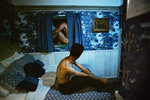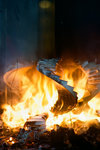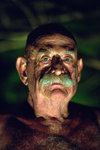


With the beach being a generous and common muse to photographers, it is rarely captured under its veil of solemnity at night, where the cool, mystic undertones of the moon replace the Technicolor haughtiness of the sun.
Fire Island photographer Matthew Leifheit, who captures brilliant, celestial bodies both at the horizon line and above, explores the vivacious life of Cherry Grove and The Pines after dark in his book, “To Die Alive,” recently published by Damiani.
The images are unabashedly erotic, but belie a sanctity in the ephemeral ecstasy of trysts in the Meat Rack, the woods that separate Cherry Grove and The Pines, where late-night and anonymous love affairs take place between the denizens of the two beaches.
Leifheit’s models are wrapped in moments of pleasure and exploration, but always aware of the tentativeness that the cover of moonlight provides them. Even in photos where there is a group dynamic, there are overtones of a Goya scene, but always celebratory and introspective in the gaze given by the models.
Often fully in the nude, Leifheit’s models, whom he gathers through friendships and open calls, are harbingers of the sans vanitas movement that has a direct link to the Baroque period.
Shot in 35-mm film, with long exposures and highly staged subjects, Leifheit does not direct his models to have specific facial expressions, but rather lets them have free rein after establishing an artistic relationship with them during the photoshoot.
“It’s almost like they’re giving me permission to hold still,” said Leifheit.
Asked what most intrigued him about the island at night, Leifheit spoke of the “blue wash” that overcomes the beach from the moonlight. The photoshoots normally take place between 10 p.m. and 12 a.m., when the moonlight is at its most beautiful, before it becomes maddening.
A place of particular curiosity that has become a muse of Leifheit’s is the black, burnt wood that evokes the “mysteriousness” of the woods.
Five years ago, a fire burned a section of Sunken Forest and left behind a skeletal system of trees covered in noir nature.
“I like the mystery of how it came to be, and I’ve known of people in our community who have spread the ashes of loved ones in these woods, especially during the height of the AIDS pandemic,” said Leifheit.
Central, but not all encompassing, of Leifheit’s work is the gay culture of Fire Island’s The Pines and Cherry Grove.
The Belvedere Hotel, “iconic of queer architecture,” according to Leifheit, is a welcome backdrop in much of the work featured in “To Die Alive,” with both interior and exterior shots.
The opening photo, where nude bodies take up artistic space on the roof of The Belvedere, is evocative of a neoclassical revival that beckons the viewer to be at one with both the male gaze and the male figure.
In interior shots of the hotel, multiple figures are arranged intimately, but always with a hesitancy before the true congress of the bodies. The highly colorized décor of the rooms are muted by the clean, fresh flesh of the subjects.
In a miniature model series of The Belvedere Hotel, Leifheit built a scale copy of the famed building and set it on fire to “imagine the pain of losing such an icon.”
The fire series, towards the middle of the book, provides the vivid colors of the flame, but still connects with the muted tones of the rest of the images.
Finally, there are the landscapes in “To Die Alive,” which come at the end of the book.
As the sun comes up, it marks the end of the revelry in the woods and a return to normal life.
Much like a sonnet within a play, Leifheit’s “To Die Alive” is a sojourn of beauty, carnal ecstasy, and requited but perhaps relinquished love, amidst a larger story.
Comments
No comments on this item Please log in to comment by clicking here